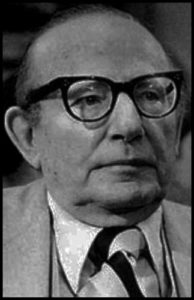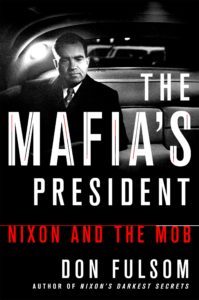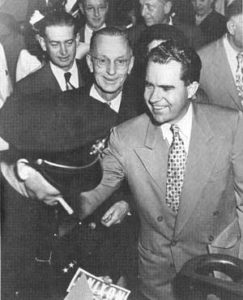by Don Fulsom
Unbeknownst to most people even now, the election of 1968 placed the patron saint of the Mafia in the White House. In other words, Richard Nixon would go on to not only lead a criminal presidency; he would be totally indebted to our nation’s top mobsters.
By 1969, thanks in large part to his long-time campaign manager and political advisor Murray Chotiner, a lawyer who specialized in representing mobsters, Nixon had participated in secret criminal dealings for more than 20 years with sketchy figures such as Mickey Cohen, Mob financial guru Meyer Lansky, Teamsters union chief Jimmy Hoffa, and New Orleans Mafia boss Carlos Marcello. And with Chotiner as one of his key behind-the-scenes advisors in the White House, Nixon’s ties to the Mafia didn’t end there. The Mafia’s President reveals a mind-blowing litany of favors Nixon exchanged with these sinister characters over decades, ranging from springing Jimmy Hoffa from prison to banning the federal government from using the terms “Mafia” and “La Cosa Nostra.” Drawing on newly released government tapes, documents, and other fresh information, The Mafia’s President by Don Fulsom offers a carefully reported, deeply researched account of Richard Nixon’s secret connections to America’s top crime lords. Read an excerpt of The Mafia’s President below.
Mobsters in Cuba

Santos Trafficante Jr., based in Tampa, was one of the most powerful Mafia godfathers in the country—and he was brutally vicious to his enemies. Known as the “Silent Don” because he was a keen adherent of the Mob’s vow of silence, he wore thick glasses and dressed more like a bank president than a hood.
Yet Santos never hesitated to order hits on fellow mobsters who tried to encroach on his territory—or who had committed, in his deep green eyes, any other unpardonable sin. Among those Mafiosi reportedly bumped off on Trafficante’s orders were Brooklyn boss Albert “the Mad Hatter” Anastasia; Chicago godfather Sam “Momo” Giancana; and Giancana lieutenant John “Handsome Johnny” Roselli. Trafficante also played a leading role in secret U.S. murder plots against Cuban leader Fidel Castro, instigated in 1959 by Vice President Richard Nixon.
By then, Trafficante had learned the intricacies of a full panoply of Mafia crimes—from common to lethal—from his dad, Santos Trafficante Sr. The senior Trafficante came to Tampa from Sicily in 1904. In Tampa, he built his crime family—which would operate there for the next 50 years. In 1954, a year after surviving a shotgun attempt on his life, Santos Jr. succeeded Santos Sr.
Over the ensuing years, political buff Trafficante became a big Richard Nixon fan, according to the godfather’s lawyer, Frank Ragano: “[Santos] viewed Nixon as a realistic conservative politician who was not a zealot and who would not be hard on him and his Mob friends.”
With headquarters in both Tampa and Miami, Trafficante controlled Florida’s illegal drug and gambling operations. His largest criminal enterprise in the state was the “bolita lottery,” a Cuban numbers game. A Meyer Lansky protégé, Trafficante could also be frequently found in Havana, where he was Lansky’s top enforcer in the Syndicate’s gambling casinos during Fulgencio Batista’s dictatorship.
Also known as “El Hombre,” Batista ruled Cuba for years through a series of puppets, and then as president by election in 1940. He met Nixon in 1955. Under Batista, corruption ran rampant. While the Cuban economy took a nosedive, the president had deposited bucketloads of funny money in foreign banks. He left the country in 1958—taking with him a fortune estimated at $300 million. Most of those funds came from Batista’s favorite partner in crime, Meyer Lansky, head of the U.S. Mafia in Havana. Batista lived the rest of his life in ritzy, sunny locales in Florida, Spain, and Portugal.

During Batista’s reign, a Santos Trafficante lieutenant named Norman “Roughhouse” Rothman ran the swanky San Souci casino for the Syndicate. Senator Richard Nixon and a wealthy California friend, Dana Smith, gambled there in 1952, just before Nixon was nominated for vice president. By several accounts, Smith lost a bundle—$4,200 to be exact. Though he gave a check to Rothman to cover his losses, Smith—claiming he’d been cheated—put a stop on the check as soon as he returned to the United States. In Washington, Smith’s Cuba gambling partner also sprang into action.
Senator Richard Nixon wrote a letter to the State Department seeking intervention on Smith’s behalf by the U.S. Embassy in Havana. By one account, mobbed-up Nixon pal Richard Danner—who knew Rothman very well—was a third member of that particular Nixon Havana gambling entourage. A separate report adds Nixon’s almost constant companion, Bebe Rebozo, into the mix on this particular junket.
By yet another account, that of Norman Rothman himself, it was Nixon—not Smith—who had lost all those thousands at the San Souci. In a major favor for Nixon, Rothman lied and covered up for the Mob’s favorite politician, though he later confessed to it. He admitted falsely telling a reporter that Nixon was not even with Smith at the casino that night. Rothman said he had further protected the senator by refusing to testify in a lawsuit brought against Smith. In response to those acts of Mafia goodwill, Rothman said Nixon sent him a verbal thank-you through another member of Congress.
Later, as vice president, Nixon summoned the loyal gangster who had shielded him from a potential Havana gambling scandal into service for a hush-hush government assignment. Always scheming, Nixon wanted to take advantage of Norman Rothman’s old Batista-era contacts in Cuba.
So in 1960, at Nixon’s direction, Trafficante and several other Mafia heavyweights signed up as co-conspirators in secret Nixon-led Mafia-CIA plots to assassinate Fidel Castro. And among the key players in implementing the plots were Norman Rothman, former Nixon dirty trickster (and Hughes and Mafia associate) Robert Maheu, and CIA agents (and future Nixon dirty tricksters) Frank Sturgis and E. Howard Hunt. All of the Castro murder plots, of course, were miserable failures: the longtime ruler of Cuba died a natural death in his homeland in 2016.

For his part in the 1960 plots, though, the fearless Rothman was able to sneak back into Cuba—where he unsuccessfully tried to enlist several of Castro’s bodyguards to carry out the assassination. The mobster was also a middleman with the CIA in the Nixon-supervised efforts to kill the Communist leader. Investigative reporter Gus Russo quotes a former CIA officer as saying, “Rothman was in touch with several CIA agents. They had many meetings concerning assassination plots against Castro.”
At the same time, Roughhouse Rothman was now funneling money from Santos and other ousted Havana casino owners into a paramilitary anti-Castro organization in Miami. Called the International Anti-Communist Brigade, it was headed by none other than future Watergate felon Frank Sturgis.
In May 1973, Santos Trafficante demonstrated the closeness of his special longtime bond with President Richard Nixon—and the unique inside information he had on the Watergate scandal—when he privately disclosed to a friendly Washington law firm that the break-in at Democratic headquarters was “ordered by Nixon personally.” The Mafia godfather said Nixon was “terrified” that the Democrats might have evidence of his prior role as organizer of the effort to assassinate Fidel Castro. (Nixon never even told the Warren Commission of those plots, or of his prior relationship with—of all people—Jack Ruby, the killer of alleged JFK assassin Lee Harvey Oswald.)
Trafficante additionally claimed that Nixon had dispatched the CIA’s chief of security, Sheffield Edwards, to Florida in late July 1960 to assure Trafficante that the vice president was indeed the organizer of the Castro murder plans. The Florida Mob boss made these revelations to investigators for prominent DC attorney F. Lee Bailey—who once represented Trafficante, and who was then defending Watergate burglar James McCord.
The godfather’s disclosures about Nixon’s role in the Watergate scandal, and in earlier efforts to kill Castro, were not made public until recently. One of Bailey’s investigators, Daniel Sheehan, revealed them in his memoirs, and in college lecture halls where he taught as a professor. Sheehan says Trafficante reported that Nixon used a secure “scrambler” phone to get Howard Hughes on board in the Castro murder scheme—adding that Hughes then chose his own right-hand man, Robert Maheu, to help coordinate the effort.
Just how did Santos Trafficante have so much intel from Richard Nixon’s secret world? Sheehan says the godfather got most of his inside information from two of his former lieutenants—Nixon Watergate burglars Frank Sturgis and Bernard Barker. The lawyers at the Trafficante-friendly DC law firm who conducted the Watergate-era interview with the Mafia don kept his disclosures to themselves for decades. And Nixon’s vice presidential sponsorship of the plots against Castro’s life was not confirmed until well after Nixon’s death in 1994.
DON FULSOM is an adjunct professor of government at American University. He is the author of Treason: Nixon and the 1968 Election and Nixon’s Darkest Secrets. A White House correspondent during five different presidencies—and a UPI bureau chief in Washington for seven years—he has written articles for The Washington Post, The Chicago Tribune, and Esquire, among others, and has been interviewed about politics on major television networks, including CNN and Fox. He lives in Washington, D.C.
